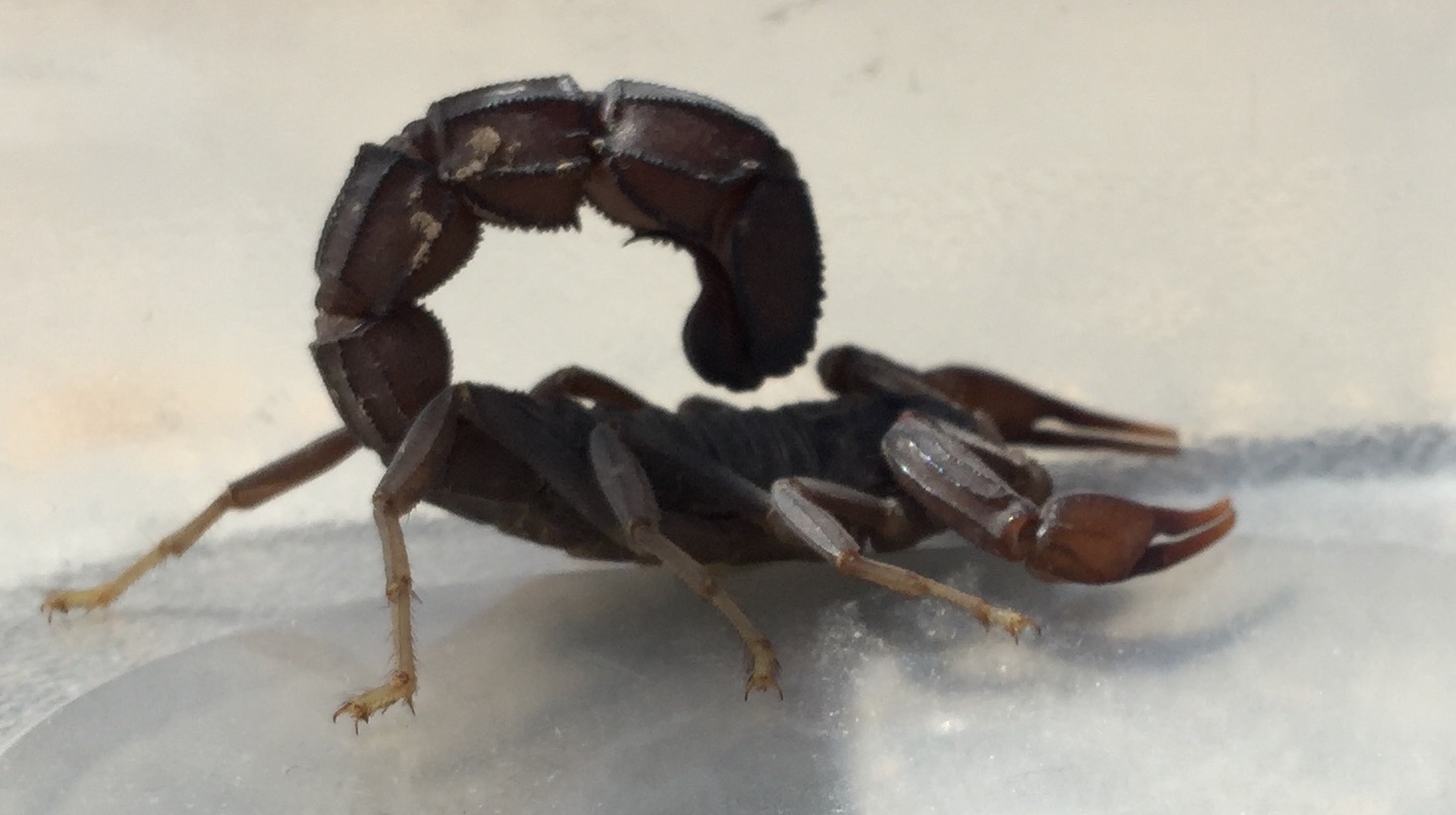Androctonus Bicolor on:
[Wikipedia]
[Google]
[Amazon]
''Androctonus bicolor'', the black fat-tailed scorpion, is a

scorpion
Scorpions are predatory arachnids of the order Scorpiones. They have eight legs, and are easily recognized by a pair of grasping pincers and a narrow, segmented tail, often carried in a characteristic forward curve over the back and always end ...
species of the family Buthidae
The Buthidae are the largest family of scorpions, containing about 100 genera and 1339 species as of 2022. A few very large genera (''Ananteris'', ''Centruroides'', '' Compsobuthus'', or '' Tityus'') are known, but a high number of species-poor o ...
. It is black in color and can grow up to 8 cm. Black fat-tailed scorpions come from the family Buthidae
The Buthidae are the largest family of scorpions, containing about 100 genera and 1339 species as of 2022. A few very large genera (''Ananteris'', ''Centruroides'', '' Compsobuthus'', or '' Tityus'') are known, but a high number of species-poor o ...
, which is the largest of the scorpion
Scorpions are predatory arachnids of the order Scorpiones. They have eight legs, and are easily recognized by a pair of grasping pincers and a narrow, segmented tail, often carried in a characteristic forward curve over the back and always end ...
family. They can be identified by their hefty physique. They tend to move very fast, and are of an aggressive nature. Black fat–tailed scorpions can live for up to 5 years. Adults can reach up to 40-60 millimeters, 80 millimeters being the maximum. These scorpions typically possess black and brown coloration. These scorpions enjoy making scrapes with wood and rocks, and are nocturnal
Nocturnality is an animal behavior characterized by being active during the night and sleeping during the day. The common adjective is "nocturnal", versus diurnal meaning the opposite.
Nocturnal creatures generally have highly developed sens ...
, thus they hide in crevices or certain objects during the day. They stay in shade to retain moisture (that they obtain from prey) in their bodies, as they are susceptible to losing moisture due to their environmental preference.
Location
''Androctonus'' is widespread in North and West Africa, the Middle East, but the wider family tolerates a wider range of habitats. This relates to the fact that black fat-tailed scorpions are rather efficient when temperatures range from 85 °F-95 °F, as this temperature allows for productive growth. Black fat–tailed scorpions are normally found in arid or semi-arid areas as well as margins of desert areas, typically areas with sandy soil. They generally prefer warm and dry areas.Taxonomy
The black fat-tailed scorpion belongs to the genus ''Androctonus
Fattail scorpion or fat-tailed scorpion is the common name given to scorpions of the genus ''Androctonus'', one of the most dangerous groups of scorpion species in the world.Hendrixson, B. E. 2006. Buthid scorpions of Saudi Arabia, with notes ...
'', which can be translated into "man-killer". The species name is ''bicolor'' which is translated into having two-colors, which could be referring to their brown-black coloration. Scorpions are under the class Arachnida
Arachnida () is a class of joint-legged invertebrate animals (arthropods), in the subphylum Chelicerata. Arachnida includes, among others, spiders, scorpions, ticks, mites, pseudoscorpions, harvestmen, camel spiders, whip spiders and vinegaroon ...
, because they are arachnids that have eight legs.

Eating habits
Scorpions can eat many kinds of insects, spiders, lizards, small mammals such as mice, or even other scorpions. Scorpions are able to go months without consuming food. Prey is captured and crushed by its pincers, while their stingers are used to inject venom into their prey. This paralyzes the prey, causing immobility and allowing the scorpion to consume it with ease. Scorpions use theirchelicerae
The chelicerae () are the mouthparts of the subphylum Chelicerata, an arthropod group that includes arachnids, horseshoe crabs, and sea spiders. Commonly referred to as "jaws", chelicerae may be shaped as either articulated fangs, or similarly ...
(small claw-like structures attached to their mouths) to pull small parts off their prey, this is simple for them as chelicerae are quite sharp. Scorpions are only able to ingest liquids, thus their chelicerae help them dispose of solid parts that cannot be consumed.
Venom
Black fat–tailed scorpions use neurotoxic venom, which is fast acting and can be absorbed very quickly, because of the small molecular weight of the proteins that make up the venom. These neurotoxins act on the central nervous system, causing paralysis in the nerves that are responsible for respiration, which ultimately causes death by respiratory failure. The neurotoxins may also cause widespread neuronal excitation, symptoms of which can include pain, sweating, salivation, and tearing. Severe envenomation is likely, as the rate of envenoming is 10-20%, making it potentially lethal. Victims are likely to feel progressively weaker after envenoming. Envenoming can result in death, which can occur between 5 and 15 hours, but it is also possible for death to occur within one hour. Examples of common symptoms that occur after a sting are: drowsiness, drooping eyelids, paralysis of neck muscles, loss of muscle coordination, and abdominal pain. A monovalentantivenom
Antivenom, also known as antivenin, venom antiserum, and antivenom immunoglobulin, is a specific treatment for envenomation. It is composed of antibodies and used to treat certain venomous bites and stings. Antivenoms are recommended only if th ...
(an antivenom that heals stings of specific species ) called Anti-scorpionique is available to treat stings from a black fat-tailed scorpion.
References
{{Authority control Animals described in 1828 Buthidae Scorpions of Africa Taxa named by Christian Gottfried Ehrenberg